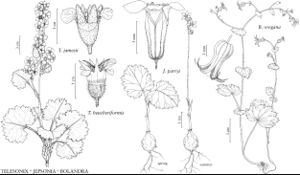Bolandra oregana
Proc. Amer. Acad. Arts 14: 292. 1879,.
Leaves: petiole 3–15 cm; blade shallowly lobed, 2–7 cm, ultimate margins serrate. Inflorescences 6–18-flowered, 16–40 cm, stipitate-glandular; bracts subtending pedicels conspicuous, auriculate. Flowers: hypanthium campanulate-urceolate, 5–10 mm, glabrous; sepals 6–10 mm, apex long-acuminate; petals usually reddish purple to dark purple, narrowly lanceolate, unlobed, 7–12(–14) mm, apex long-tapered; stamens included, 2 mm; ovaries connate proximally 1/4 their lengths; styles barely exserted, 2 mm; stigmas distinct. Capsules brown, ovoid, 8–9 mm. Seeds 100–125, 0.7–9 mm. 2n = 14.
Phenology: Flowering May–Jul.
Habitat: Wet, shaded, rocky crevices and cliffs, usually near water courses
Elevation: 0-1400 m
Distribution

Idaho, Oreg., Wash.
Discussion
Bolandra oregana is found in northern Oregon and southern Washington in the vicinity of the Columbia River gorge and in the Snake River region of eastern Oregon and Idaho.
Selected References
None.
